Missed out on our Revolutionising Retail Webinar? Watch it here.
Have you ever wondered how brands and retailers can continue to drive footfall and shopper engagement in an ever-changing market?
From the integration of new technologies to sustainability-focused solutions, join Displayplan’s Retail Experiences Director, Leon Turney and Retail Expert and Influencer Ian Scott as they share some invaluable insights into the top trends currently taking the industry by storm.
Watch Revolutionising Retail Webinar
Meet the experts

Over the past 12 years with Displayplan, Leon’s passion and enthusiasm for innovative retail experiences have contributed to his growth as a retail expert. Leading our drive into digitally integrated displays with our clients. Leon is well-equipped to deliver awareness around the key factors shaping the future of retail.

With over 20 years in the industry and a place as a Top Retail Influencer, Ian is guaranteed to provide some insightful viewpoints when it comes to the world of retail. Today, Ian has utilised his fascination and experience of retail to form his own consultancy; solidifying his position and understanding of the shifting retail landscape.
Have you ever wondered how brands and retailers can continue to drive footfall and shopper engagement in an ever-changing market?
As we move further into the blossoming new age of retail, our Retail Experiences Director, Leon and Retail Expert Ian are getting ready to share some invaluable insights into the top trends currently taking the industry by storm.
From the integration of new technologies to sustainability-focused solutions, join our webinar at the beginning of June as we uncover the ways to innovate in-store experiences, in line with these transformative trends.
Date: 6th June 2023 at 14.00pm Price: Free
Meet the experts

Over the past 12 years with Displayplan, Leon’s passion and enthusiasm for innovative retail experiences have contributed to his growth as a retail expert. Leading our drive into digitally integrated displays with our clients. Leon is well-equipped to deliver awareness around the key factors shaping the future of retail.

With over 20 years in the industry and a place as a Top Retail Influencer, Ian is guaranteed to provide some insightful viewpoints when it comes to the world of retail. Today, Ian has utilised his fascination and experience of retail to form his own consultancy; solidifying his position and understanding of the shifting retail landscape.
Register your interest for webinar

This month we follow our Creative Director Dudley and the team on their visit to EuroShop 2023.
Some of you may have already seen these highlights, but if you haven’t – Click here to see how a new take on existing technologies can engage, excite, and activate the imagination of shoppers.
This year the themes of discovery, play, intrigue, and user creation really energised our team. Meanwhile, the theme of sustainability remaining high up on the agenda ensured they were left reassured that important issues weren’t being ignored.
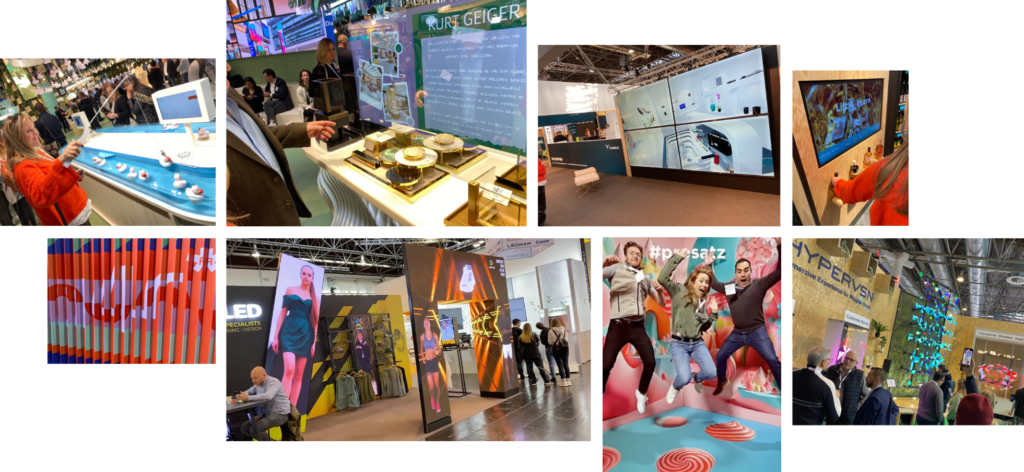
At first the concept of insight driven design seems like a no brainer, if you’re not designing with the driving force of insight, then what are you designing to?
The truth is there are many ‘drivers’ for design, from wider macro factors such as technological advancements, or trends towards sustainability, to more detailed micro factors such as budget or clients’ requirements or interests.
And of course, what we value individually and as a company, and what our clients value plays into what we design. However, the uniting factor is and always should be meeting the needs and desires of the shopper.
Frombrief all the way to concept and build, our account team, strategists, and designers, draw on their years of experience to cater to the needs/desires of shoppers through true insight. Taking a human-centric end user (shopper) approach to innovative in-store design.
It’s easy to confuse insights and facts, however, so what is insight?Insight is not as simple as “women wear makeup”, it’s about finding a crucial tension within the information to unlock growth, and opportunities to connect to an audience. That said, when an insight is uncovered and understood, there should be an ‘of course’ simplicity to it. Its at this point one knows it rings true.
For us, being insight driven is about using an in depth understanding of 3 of the 5P’s – People, Place and Promotion to deliver objectives. Rather than being reactive and meeting our clients briefs to deliver tactical responses across those elements of the marketing mix, the earlier we get involved with the marketing process, the more fruitful the result has proved to be.
When our clients share detailed Demographic, Geographic and Psychographic knowledge of their audiences, we are able to use the lens of shopper understanding to find the ‘silver bullet’ which enables us to deliver effective and impactful in-store solutions. Where this isn’t possible and our clients are looking to us to uncover insight, we’re able to apply generic shopper insight, and detailed understanding of their product, business, and market to develop meaningful insights for use. In the following examples you will see instances where we had a more prescriptive and more open brief from our clients.
Garmin MID system
A celebrated and respected brand with a strong following amongst both amateur and pro sports audiences. These are people who already know they want a Garmin watch however they perceive Garmin to be a complex family of products which hinders the purchase process.
Visibility (to attract) and accessibility (to engage) were key in this in-store solution that was created for Swedish Stadium sports stores. Shoppers needed an area where they could browse easily. Somewhere they could interact with the product, learn, and be aided in their purchase choice.
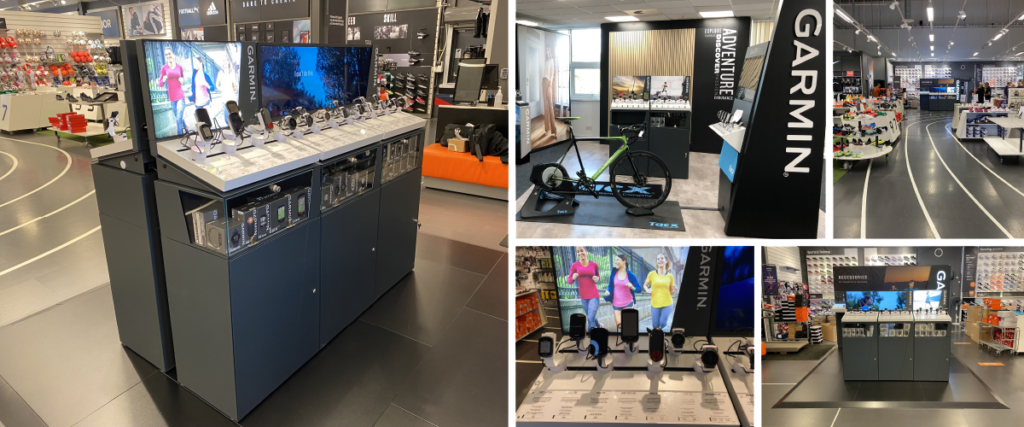
Insight
“I want to browse in-store and learn but I don’t want to be bombarded by salespeople or overwhelmed with intricate information.”
Solution
A modular display system in which 8 core displays are made from 15 key components.
Result
Retailers benefitted from increased sales. For example, store with smart screens, plus lift and learn features in Sweden sold more products. POPAI Sports and Fashion Gold Award Winner.
Braun: Pop-up shops
Braun is a well-known, well-loved brand, popular with audiences who are well aware of the products they offer. However, category wide, foot traffic to traditional department store has dropped in recent years and shoppers are turning to online or electronics specialists.
Subsequently when shoppers seek out electronics, they have standardised, full category engagement rather than a specific brand experience which can be complicated and overwhelming.
We were tasked with finding ways to attract shoppers to physical retail locations instead of ordering online. Blending physical, digital and shopper behaviour to give a compelling reason and reward to visit physical stores.
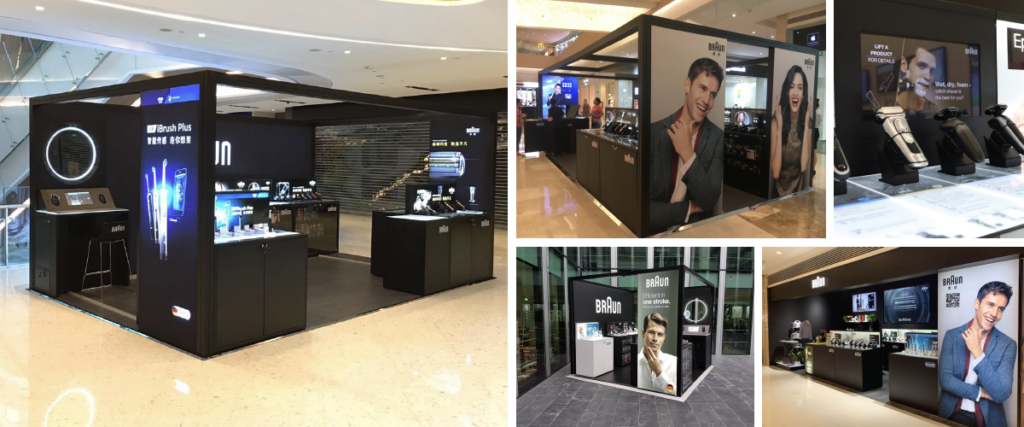
Insight
“I like Braun products, I’m fairly well-informed about the range, everything I need is available online and often at better prices and I see no real need to go into a store to buy.”
Solution
To reconnect to audiences. Using relevant integrated technology, create real experiences that connect to a wide set of audiences. Give shoppers a reason for visiting a store, through a tangible benefit:
- Cash Back (X% discounted purchase price or rebate)
- Warranty Extension (+X years on top of base manufacturer warranty)
- Satisfaction Guarantee (100 days satisfied or money back)
Shoppers are encouraged to share their email and personal details for these reward or experiences only available in-store.
Modular systems scalable and adaptable to any footprint. Using relevant technology to appeal to the wide demographic was key. This included welcome and large format attract screens, QR for engagement through Mobile phones, freestanding interactive kiosks, magic mirror technology, play-tables and in-aisle lift and learn; all used to provide personal messages, easy in-store navigation, easy product range browsing, education, comparison and guidance. These solutions were designed to create visibility for shoppers, to inspire storytelling, and prompting social media sharing and conversation.
Placing brand experience pop-ups in high-traffic mall and shopping centre locations, drives footfall and captivates new shoppers.
Result
Pop-up shops outperformed shop in shop installations in nearby department stores with greater sales. Subsequently the pop-up solution won the POPAI Pop-up Shops Silver Award.
Craig & Rose
We were tasked with creating an immersive in-store experience that introduces urban Glasgow artisan shoppers to Craig & Roses’ latest product ranges, bringing the boldness, individuality, and progressiveness of the brand to life!
Craig & Rose needed to separate themselves from other retailers in the area, and to ensure clarity about their prestigious offering. This was an opportunity to break out from existing store formats to create a more unique, bold, and creative space.

Insight
“I love shopping locally in Glasgow but none of the high street shops I see satisfy my artistic side with design appeal.”
Solution
Appealing to the local Glasgow artisan audience with a dynamic kinetic sculpture, using latest paint colour range, combined with an inspiration table to create a focal point in-store. This all draws foot traffic inside from the street for one-on-one consultations and engagement. A cosy aesthetic achieved with a dark colour palette, inspired by local architecture, highlighted the high-end design appeal of this brand within a new unique bold format.
Result
A space that draws consumers into a unique brand and product experience that gives a satisfying reason to visit the store. Elements of this bold solution are being filtered into mainstream store test and trial formats.
In summary, insights incorporate multiple lenses but must be singular, concise, and clear.
Hard sales data, business goals, client KPI’s, quantitative research all factor into insight creation & solutions provided, nevertheless it’s the softer quantitative audience research, to understand the why and to uncover that crucial tension, that unlocks growth. Digging deep to understand the end user or shopper and putting their desires at the centre of the solution better is crucial to creating effective in-store solutions.
If you are interested to know more about any of our case studies, or to speak to one of our team members. Get in touch via our contacts page. We’d love to hear from you.
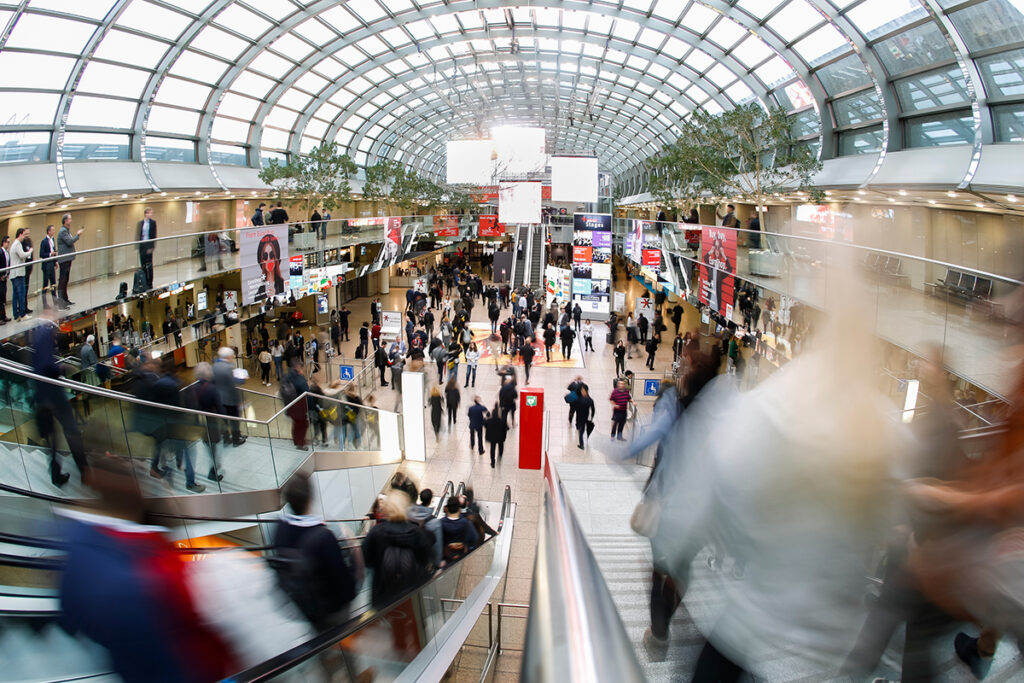
If you’re going to EuroShop, why not meet up with us, we’d love to catch up with friends, old and new.
Register your interest below and we’ll be in contact to arrange a meeting.
Register your interest
From 26 February to 2 March 2023 EuroShop, The World’s No.1 Retail Trade Fair, will bring together the international retail world and its partners at the Düsseldorf Exhibition Centre for the 21st time. It serves as the international highlight for the global retail sector this year – and will be as important as ever, especially after the last three challenging years.
We won’t have a stand at the event, but all of our Displayplan staff will be in attendance, ready to meet up and discuss any retail experience ideas you have. Register your interest above to book a meeting with us.
We look forward to meeting you!
Shop-in-shop or ‘retail concessions’ are not a new concept. It was department stores that kicked off the business model a staggering 150 years ago thanks to an inspired Parisian called Aristide Boucicaut.
In the last few years though, we’ve seen the closures of department stores worldwide and a shift to seeing concessions in new and sometimes surprising places. In hindsight though, where we’re seeing these new concessions and what those concessions are – make absolute sense.
It’s been a number of years that we’ve had Costa coffee shops in Tesco stores and M&S stores, Habitat in Sainsbury’s, and Starbucks in several retailers including Amazon Go stores. The latest that consumers might delight in is Holland & Barratt and The Entertainer toys in Tesco stores, Paperchase in Next stores, or more notably ‘Garden by Homebase’ in select Next stores. (Side note, Next’s retail business strategy is captivating, and we’ll be writing about this in the coming months)
Across the pond, brick-and-mortar Toys “R” Us stores are back, with Macy’s announcing the opening of stores in 9 US states, with another due to open in a further 19 states before the holiday 2022 shopping season.
There is a lot of change afoot, and whatever each parent retailer’s shop-in-shop’ strategy, one can only assume that the relevant departments are due to have a busy few years ahead. It seems every day there’s something new to digest in this space.
So, what is happening?
The most obvious place to start is the pandemic. Significant shifts happened during this time and digital progress took great leaps forward: Online purchasing skyrocketed with PWC reporting that 16% of consumers now say they intend to purchase more online (1), and people were suddenly accepting of online education, concerts, and socialising.
Although online sales have jumped the previous trajectory of online shopping, there is still a need for a physical destination. Having a destination offers advantages that online shopping cannot: In person expertise from staff, product sampling, brand immersion, and a sense of community.
According to Trendwatching bricks and mortar retail will still have a firm place in consumers’ thoughts and behaviour as they look to reclaim their local and maintain a State of place. 53% of people polled were more interested in shopping locally than before the pandemic (2). And ‘near me’ shopping searches remain popular. Additionally, they say brands that look to make those ‘local’ spaces better will hold a particular affection in the minds of consumers.
Responding to these shifting behaviours, supermarkets and retailers like Next have searched for ways to re-establish the pull of the destination, enhancing the in-store shopping experience for customers, and encouraging dwell time.
As we now face more economic uncertainty, consumer behaviour is set to take another dramatic shift. Particularly in the UK, we can expect to see people cutting back on spending, trading down, and shopping around for better deals. This lack of loyalty will naturally affect both brands and retailers. Therefore, placing oneself firmly on the destination map and placing consumers at the heart of the retail offering, and catering to their needs has never been more important.
So how do you maintain your brand essence when you’re in someone else’s space?
Besides the destination, the intricacies of concessions are unlikely to have changed much. However, this is a relatively new play for some parent stores, and for the brands, this is a new partner also. Although this is a win-win for both parties, as with any new joint venture there are intricacies that will need close monitoring. Particularly when it comes to maintaining your brand essence in what may be a complex space.
To ensure the brand essence of both parties is upheld and respected, solutions for providing great brand experiences within parent shops are as dynamic as one would expect. Finding a display partner who is capable of supporting the shop-in-shop relationship and its intricacies is vital. At Displayplan we believe that flexibility, a detailed understanding of both parent and concession shops, scalable end-to-end solution focus, and a deep understanding of consumers, are the backbone of any good shop-in-shop relationship.
Let us talk you through a couple of examples:
Braun Lighthouse Boutique Media World, Rotterdam

Braun products are sold in a variety of different parent stores, from pharmacists to electronics specialists. Creating brand destinations and helping shoppers engage with the full Braun range completely separate from any influence from the wider category is key. In this Braun ‘lighthouse boutique’ at Media World (MediaMarkt) in Rotterdam post build 100% of Braun and Oral B products were demo-ready and shoppable where previously only 50% of the range was on the shelf.
As with all retail builds, the parent stores’ requirements and store layout must be respected, and this can sometimes mean thinking outside the box and working within a physical environment that is not traditionally considered ‘on brand’ for Braun. Here we designed the perfect blend of brand and product experience with product stock instantly available thanks to clever hidden storage.
Drawing on years of experience in understanding both the brand and the parent store ensures we have the ability to provide the design vision as well as deliver an engaging, and impactful digitally supported interactive experience. With this new design, a sales associate was given a discreet partition to work within and was therefore available to provide shopper assistance with comparison and selection. With this particular case our client was delighted with their sales uplift goals.
Garmin concession, Stadium, Malmo, Sweden

We work with Garmin market teams across Europe to deliver Garmin retail experiences that are inside different types of sport retailers from generalists to specialists like bicycle stores.
Placing Garmin inside a parent store we have to understand the retailer’s brand and physical requirements, as well as local health and safety regulations. We create a complete design layout for approval by both Garmin and the retailer, ensuring the right hierarchy of messaging is complete, and products are presented in a way that best allows shoppers to test and trial the Garmin products in that store.
Stadium stores in Sweden are all unique in size and floor space, and the placement of Garmin’s concession was often unknown. Therefore, a number of aspects were critical to success: displays needed to be modular and fit within the slat wall systems of Stadium stores, they needed to be flexible enough to fit wherever they were positioned. Equally displays needed to be eye-catching and incorporate digital elements, accessory-specific zones were needed, and lastly, consumers needed to walk away with absolute clarity on how these products could potentially impact their sporting life. As always Garmin’s product needed to be the hero, and the space needed to be owned in a very Garmin specific way.
In conclusion
Overall, the new breed of parent stores we are seeing is a win-win for brands and retailers alike. Partnering with recognisable brands and retailers gives parent retailers benefits not only from rented out floor space, but also offers a new way to engage with potentially a different audience.
The concession of course benefits from a captive audience and increased footfall placing their product in front of potentially a greater audience than they might find on the high street.
As ever though, it’s the consumers’ needs that should be at the heart of what both the parent shop and concession does. According to Simon Quirk of Kantar – “the key to a good concession strategy is to really understand your shopper demographic and the nuances of your local catchment area – who is coming through your doors, what are their spending priorities and where else do they regularly shop”
Whatever it is consumers are looking for it is our job to provide this for them, so paying close attention to not only accelerating consumer trends but also keeping an eye on wider macro factors will prepare us for the next event; be that a financial downturn, supply chain issues or another pandemic.
(1) Where next for retail – Strategy&, PWC
(2) Trendwatching report 2022
Viral – the holy grail for retailers and marketers alike. When your efforts are so shareable, they are dispersed by consumers in the digital world, hopefully taking your return on investment into the stratosphere, and making your retail store/brand top of consumers’ minds for a long time to come.
It’s said that the new generation is losing interest with in-person retail, although in the last few years cultural and technological shifts, such as influencer marketing and augmented and virtual reality, have seen more shopping experiences become ‘destinations’ as people seek out what others have enjoyed. If life in a post-pandemic world feels a little heavy, some levity and fun is seen as the ultimate remedy, and fully immersive retail experiences are retailers’ answer to that.
This ‘pull’ strategy looks to create active engagement and more importantly interaction with the shop, be that through interactive displays, augmented reality, or heavily curated shop content that inspires and excites, there are opportunities aplenty.
We are often told that one can never aim to make marketing viral, but there are a certain set of factors that come together to make planning for viral a possibility. In this article, we’ll look at examples of retail from around the world that illustrate the different pathways to achieving viral status.
A picture tells a thousand words
You only have to visit the Tate Modern in London and attempt to buy tickets for the Yoyoi Kusama exhibition (sold out months ahead of time) to understand the power of shareable visual spectacles. This is exactly what the opening of the third Chengdu Louis Vuitton Maison in mainland China was counting on.
The vast 10,700 square feet space houses a full range of Louis Vuitton products, but as a mark of respect, it is also filled with artwork and furniture by Chinese artists and designers. Not least of which was the giant tiger tail installation in celebration of the Chinese new year, which blew up on Chinese social media. Furthermore, by creating an in-store fashion experience that also celebrates other forms of art and culture, Louis Vuitton benefits from the enthusiasm around other artists through multiple touchpoints, and industries.
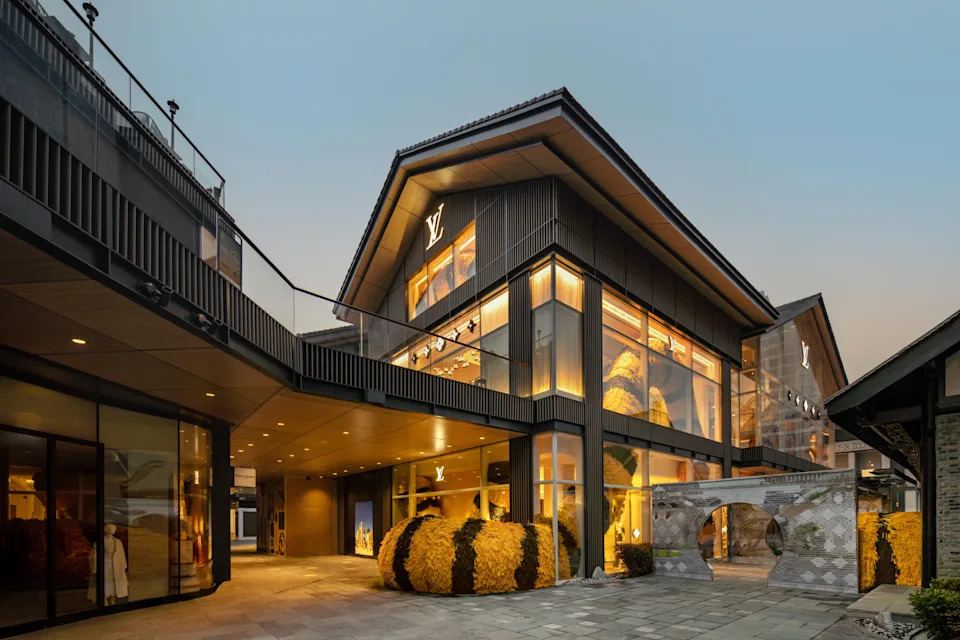
Carefully curated inventory creates curiosity
Sezane L’Apartment was designed to form an intimate welcoming space that felt like a home. The original Parisian flagship store has a cinema, library, and a café. So, when Sezane opened their flagship US store in New York in 2017, with their same curated collections, a café serving complimentary drinks, bakery goods, and a florist workshop, they offered customers a shoppable ‘apartment’ experience they wanted to share.
With a desire for a chic French lifestyle, New Yorkers were hungry to get a taste of sophisticated Paris, and Influencers like Joanna Goddard from Cup of Jo fame, and Julie Sarinana, Sincerely Jules jumped in and added to the digital buzz using the hashtag #bonjournewyork, as per the eye-catching mosaic entrance greeting. A hashtag which is still used today when people visit the store.

Make their reality virtual
Nestled in hundreds of TOMS stores worldwide, you’ll see customers drinking TOMS coffee and wearing a VR headset, as they explore Peru, in the “Virtual Giving Trip”.
It’s long been a key ethos of TOMS to give back, donating £1 of every £3 they make, and donating one pair of shoes for each pair bought. So, when TOMS partnered with Samsung to deliver the award-winning 360-degree video experience, customers were transported to Peru. There they experience the impact TOMS has on these communities as TOMS teams deliver shoes to schools. Described by TOMS founder Blake Mycoskie as “the greatest technology to create empathy” – The Virtual Giving Trip not only explains the OneForOne ethos when you’re buying shoes, but it also deeply feels that you have given shoes to children in need, making the campaign a success as it immediately connected, making the experience simultaneously shareable and worthy.
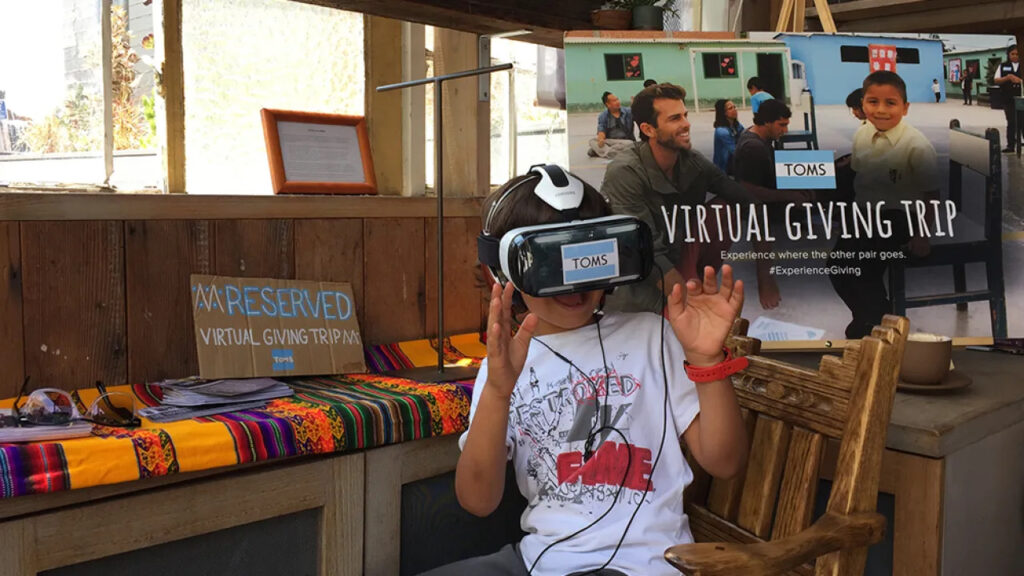
Online-offline
Digitally native brands are increasingly opening physical stores, one great example whilst not strictly viral in its categorisation, is the Beauty Pie pop-up in London this summer. This pop-up created an immersive environment for consumers to engage with the brand, its’ products, the labs that create their high-end products, and discover how it operates.
Already disruptive in their nature, this brand seeks to cut out the middleman and offer customers premium beauty products at factory prices. By creating a short-lived (just 11 days) pop-up store right in the heart of London, they created a buzz and excitement playing on the notion of scarcity, that had Beauty Pie on the lips of many long after the pop-up had closed.

What we know
The takeaway from these viral experiences is that creating conversation, excitement and a shareable customer experience will place your retail store firmly on the ‘destination’ shopping map.
How this is achieved – be it through collaborations with influencers, partnerships with artists, employing technology advancements, or by employing the excitement of scarcity in pop-up form -ensuring you are part of popular culture is an absolute must. Relevance is key and maintaining a degree of delight by altering the mundane of reality will create advocacy and loyalty in the long term.
Next Steps
If you’re a retail brand or marketing exec looking to inject some immersive design into your display designs, speak to Displayplan about how we can create the perfect in-store experience for you. Contact us today.
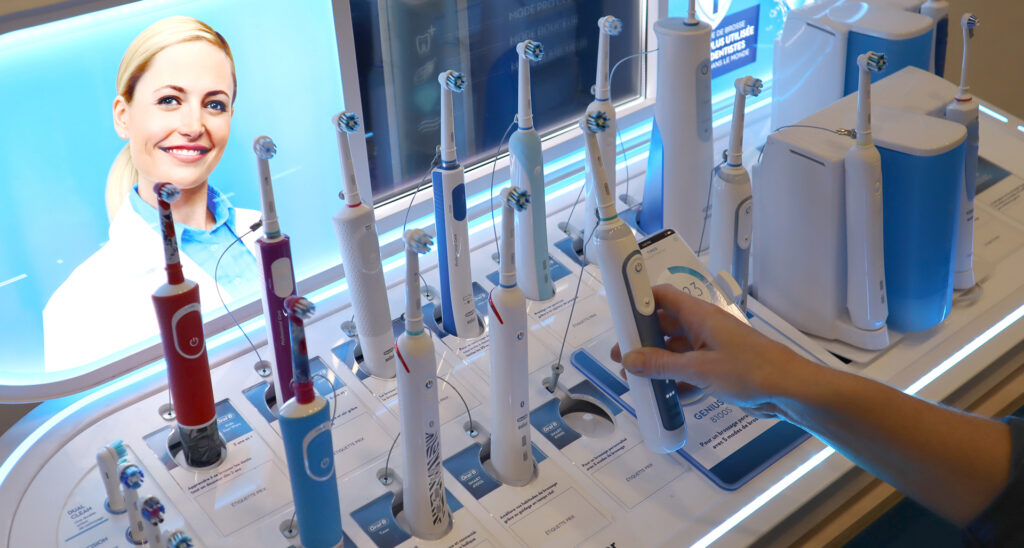
Brand and retail professionals know that delivering memorable instore retail experiences is the only way to attract and engage increasingly savvy shoppers.
Improved experiential retail is about enhancing the whole shopper journey, from the point of initial awareness, through the anticipation and expectation of the in-store shopping experience to the impact of the experience itself. It also extends to the payment and post-checkout process.
Whether through hands on try-out experiences or VR or interactive displays, physical retail stores must constantly vie for attention against their online ecommerce competitors, by using technology to differentiate an in-store visit and connect with customers.
With 77% of Gen-Z shoppers saying they’d prefer to shop in-store rather than online, this is the perfect time for brands to explore and invest in the many shapes and forms experiential retail comes in.
Personalisation and Interaction
One way that retailers can ensure that their in-store display solutions are keeping pace with evolving shopper expectations is to recognise and respond to the growing demand for personalised experiences that has become the norm of online shopping.
Many retailers are investing in technology that sends personalised messages and videos to customers based on factors such as their location or use of an app. These personalised touches make customers feel valued but also capitalise on the fact that shoppers are increasingly willing to interact with displays using their smartphones, thereby creating their own personalised shopping experiences.
Research from Google shows that 84% of “smartphone shoppers” already use their phones in-store to help them decide what to buy. Retailers that are tuned into this offer their customers the option to access tailor-made retail assisted shopping solutions by scanning a QR code or barcode and providing their personal information.
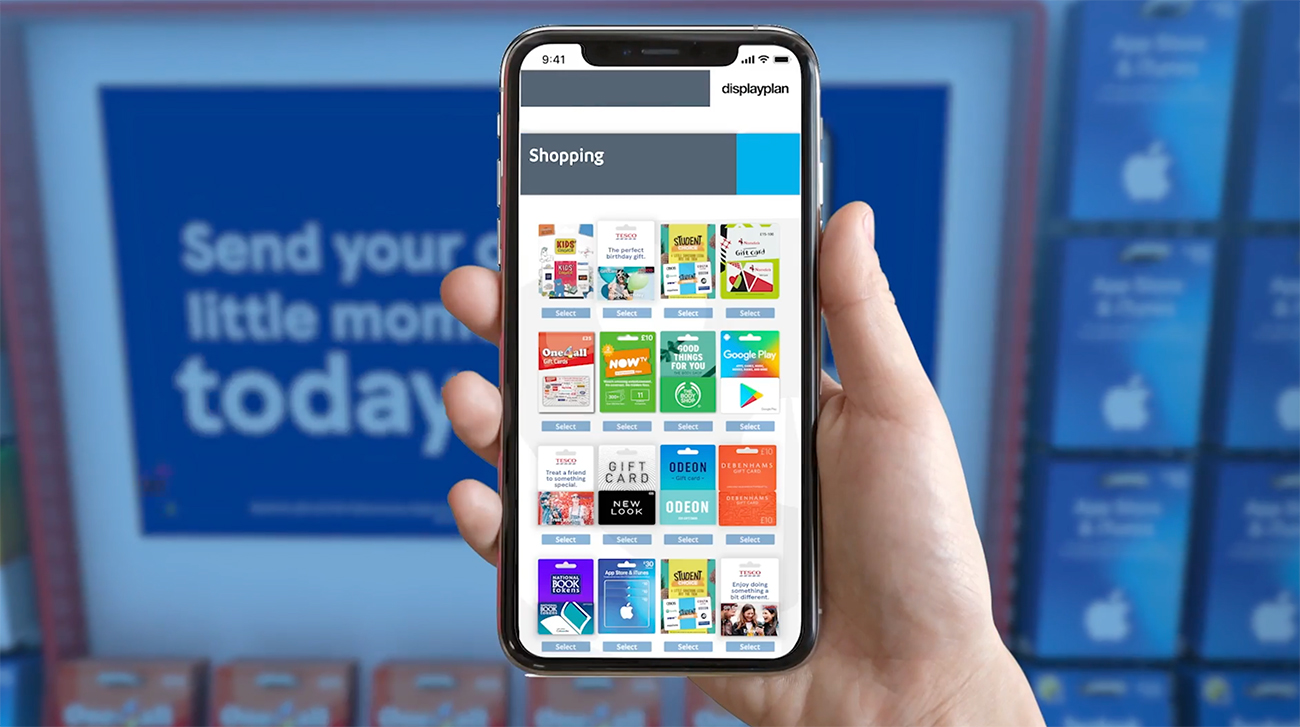
Immersive Experiences
When it comes to truly immersive retail experiences, it has to involve augmented or virtual reality.
Augmented reality gives customers the opportunity to try before they buy as was never possible in the past. For example, cosmetics company Sephora have invested in Virtual Mirrors that allow customers to see themselves digitally wearing different make-up looks.
Virtual reality is being used to satisfy customer desire for both the convenience of shopping online and an in-store experience. Virtual showrooms allow the customer to navigate a simulation of a store as if they were there in person. There is potential for the technology to integrate a social element whereby customers can shop with their friends online.

Multichannel
Multichannel retail offers shoppers the opportunity to use whatever devices and platforms they want to, at different points and times throughout their purchasing journey. For example, a customer may see a product they like on social media, then visit the brand’s website on their laptop or smartphone, followed by using in-store display technology such as lift-and-learn to explore the product before finally buying it.
Customers should be able to move seamlessly between these devices and platforms whenever it is convenient to them, and the transition from online to offline should be as easy and smooth as possible.
Multichannel experiences are essential not just for attracting customers but also retaining their attention along their shopper journey, using experiential technologies both online and offline to maximise their propensity to convert. These seamless multichannel experiences are more likely to result in a sale because shoppers do not need to repeat actions across multiple devices and channels.

Retailtainment
Retailtainment describes adventurous experiential retail. It is used to put customers in the mood to spend through the means of stimulating features, such as opportunities for interaction. For example, Adidas have developed a ‘Bring it to me’ option in their app for in-store shoppers. Customers can simply take a photo of the shoe they’d like to try on and a shop assistant brings it to them by accessing their location on their own device.
Unique retailtainment innovations like this excite customers and drive them to share their experiences on social media, thereby creating free marketing for the brand.
Lift and Learn Technology
Lift and Learn technology allows customers to experience the best of what both offline and online shopping offer. Shoppers are given the opportunity to be hands-on with a product whilst also receiving extra information, such as stock, reviews and accessory recommendations, usually only available when buying online.
For retailers, offering shopper experiences using these technologies can reduce return as by exploring product features, usability and ergonomics more thoroughly pre-purchase enabling customers to be more confident about their purchase.
Through integrated monitoring technology, brands are able to gather valuable data around shopper behaviours in response to these retail experiences, as well as enhancing engagement and conversions.
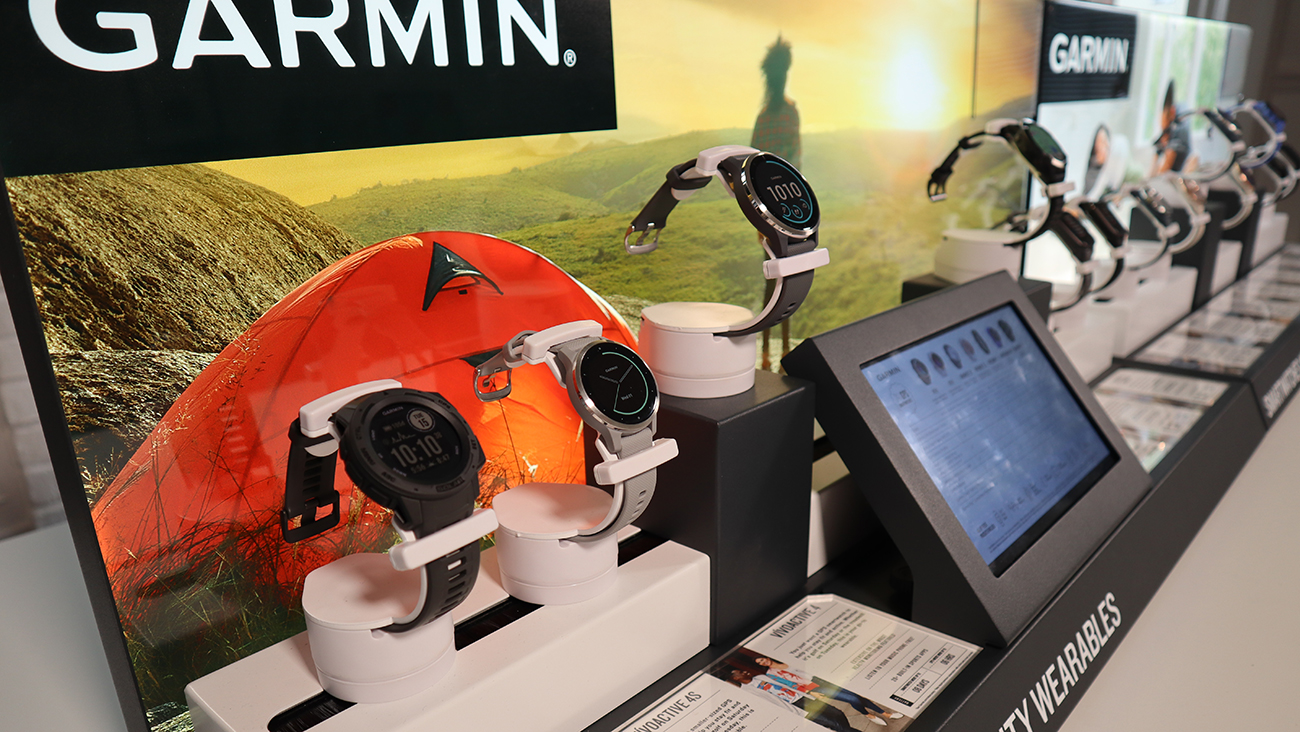
Wayfinding
Wayfinding is another key ingredient of the overall retail experience, and can play a huge role in influencing shoppers towards a purchase decision.
As a key element differentiating online from offline shopping, retailers are increasingly paying closer attention to wayfinding in-store using physical display and technology innovations. By getting this aspect of the retail experience right, retailers can help shoppers feel the benefit of being guided around a store, yet loosely enough that they are energised to purchase by a sense of their own autonomy.
Wayfinding adds elements of excitement and sophistication to retail experiences – for example with wayfinding technology such as apps that guide and direct shoppers virtually in- store – yet also simplifies and enhances the overall shopping experience.
Next steps
At Displayplan, we think retail displays should be designed to offer personalised, hands-on, educational and informative experiences. Displayplan helps its clients develop personalised retail experiences that appeal to the senses and emotions of target shoppers. We design your retail display to offer shoppers the opportunity to engage with your brand, experience your products and become invested in them. Speak with one of our retail display specialists on 01462 88 6000 or email info@displayplan.com.
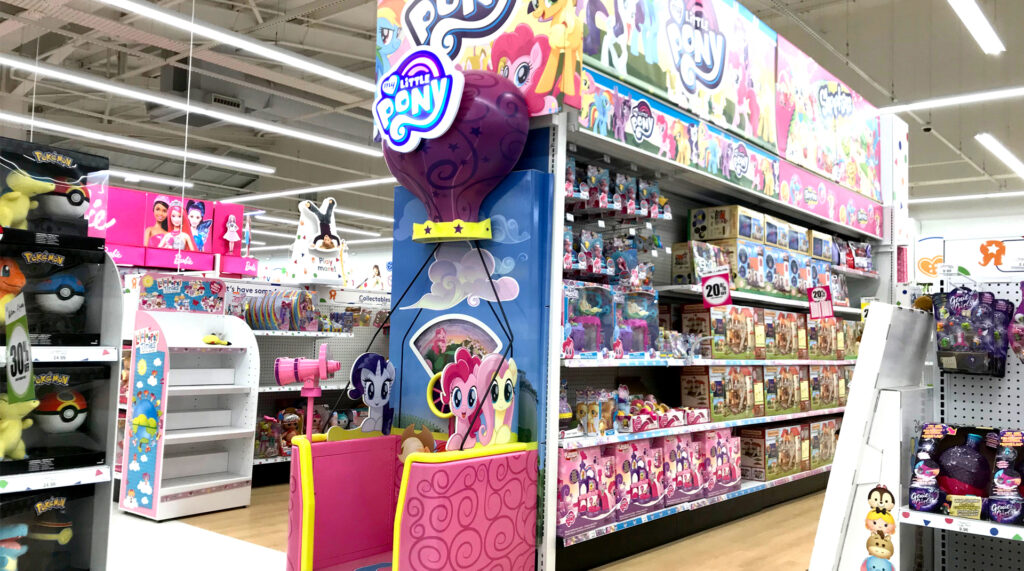
Experiential retail display is widely used to influence shopper behaviour through entertainment and/or education in-store.
Designing in-store product displays that appeal to shoppers’ senses doesn’t just attract and engage them whilst in-store; it also enhances their shopping experience and helps drive sales.
Recently, a survey of over 5,000 fashion buyers showed 44% of people were more motivated to visit a physical shop that gave personalised offers to use in-store and linked to digital experiences.
This, along with countless more statistics, shows the importance of integrating on-line with off-line, technology, entertainment, connecting seamlessly for experiences that enhance digital and physical shopping.
For retailers and brands, experiential display solutions must centre around performance, both for the shopper and bottom-line sales, incorporating elements of interactivity and originality while creating a relationship between the shop/product and the consumers.
There is one key ingredient that helps ensure these elements are met.
Creativity.
Designing retail experiences is about thinking outside the box, being unique and promoting innovation.
What does it mean to be different?
In-store experiences can be physical, digital or a combination of both. The way that these interact seamlessly is important to the shopper journey. Overall, the shopper should be given opportunities to touch, feel and interact with products while in the store in a memorable way.
Yet being different doesn’t always mean doing everything new.
Shaking up the norm and including relevant experiences within physical designs can be a great way to add a wow factor to your in-store marketing. Creating unique, creative, and well-thought-through experiences provides exciting, unexpected moments that help reflect your brand and messaging, putting your product in the spotlight.
Why your customers seek unique experiences
The COVID 19 pandemic has changed shopper behaviour. Retail has had to change, it’s now a complex ecosystem of physical spaces and digital consumption. The purpose extends far beyond displaying and selling products and services.
Shopper behaviour has driven the need to merge social interactions, fun, entertainment, and learning experiences.
In February 2021, up to 71% of people were buying more online than they ever had before. Now, with lockdown restrictions lifted, businesses are faced with more pressure to encourage shoppers back to the high streets.
Where online retail cannot compete, is in offering hands-on, in person experience. Experiential retail displays offer shoppers the chance to interact with products, allowing them to touch, feel, hear, and smell, enhancing their retail experience through entertainment and education rather than simply enabling a purchase.
The role of stores has evolved, turning them into places that offer meaningful interactions with customers. The entertaining and often education and playful experiences which are only available in-store is rapidly becoming a fixed part of shoppers’ expectations.
Physical retail stores are only part of a wider system of shopper experiences that must connect seamlessly at all touchpoints.
How you can harness more creativity in your next retail experience
At Displayplan, we are pragmatic in our approach to creative ideas and solutions. First, we make sure we understand the problem, client goals and objectives.
Then we apply a ‘what’, ‘why’ and ‘how’ methodology that justifies our thought process, answers the client brief and offers additional insights that enhance the final solutions.
We always begin the creative process by considering all the steps of the whole project, right through to end of life recycling and reuse. This ensures we create ideas at the start that can be realised and look just like the first visuals.
By working in this way, we aim to make at an experiential display solution that:
- Delivers an enhanced shopper experience
- Achieves our client’s objectives and solves the problem
- Incorporates our sustainable design thinking approach by including materials that can be reused or recycled at end of life.
Creativity at Displayplan means thinking through relevant solutions to the challenges set for us by our clients. Not just design-led ideas, but the ability to see through the issues and navigate the complete project process from sketch to store.
Yet while creative idea generation processes are in themselves exciting, the limiters faced by many retailers have to be considered. Creating great-looking, engaging retail display concepts is only part of the story; the other side is being able to implement these ideas within the confines of client budgets. This is the art of realising solutions.
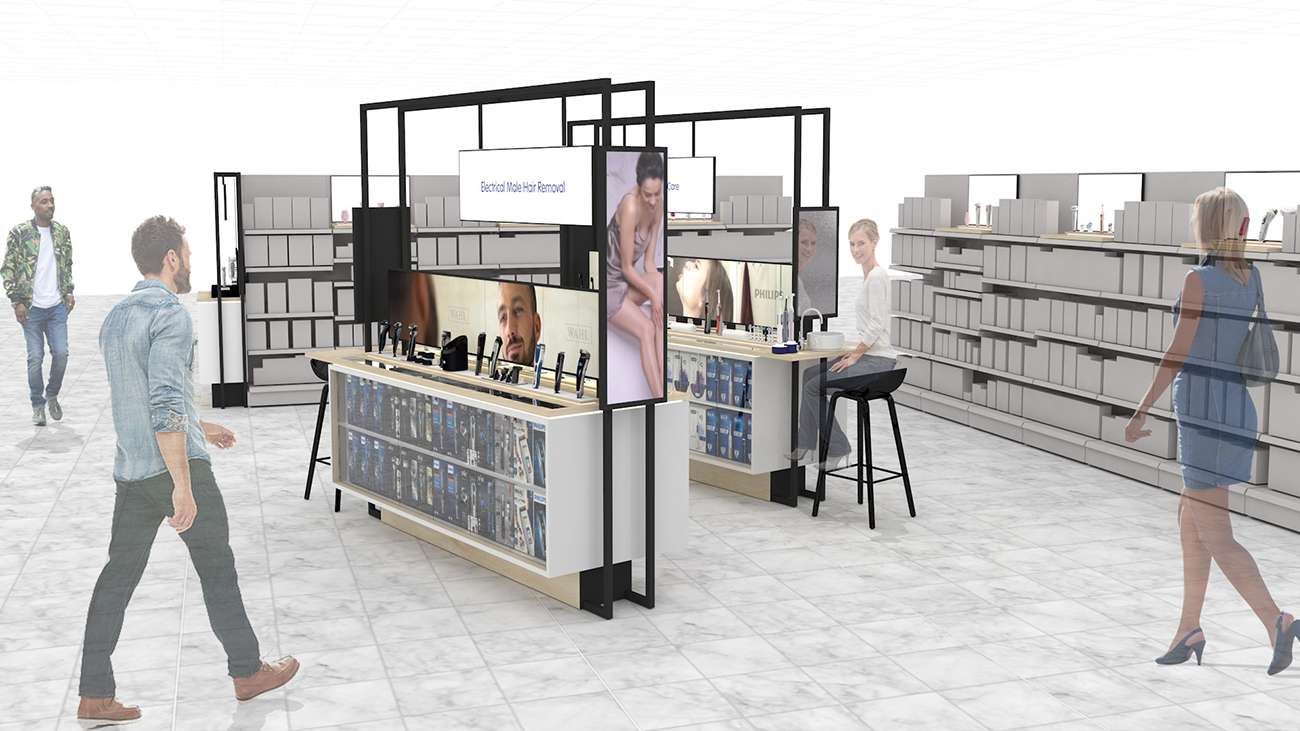
The results of differences in experiences
We continually watch what’s happening in the market, keeping in touch with and understanding shopper behavioural change.
Our designers blend creativity with insights to form the reasoning for relevant ideas and design directions that respond to changing global trends. Keeping an open mind and promoting curiosity gives our team new evolving approaches to what we do.
This approach has inspired a range of highly innovative and successful experiential retail displays, such as Hasbro’s immersive in-store My Little Pony brand experience for children. We built a custom 3D immersive virtual reality experience of the world of My Little Pony with 360-degree content, delivered through a mobile phone integrated within play binoculars. This award-winning solution was designed and custom-built for retail stores, including a built-in fan and sound effects.
More recently, Displayplan developed an award-winning play table concept designed to showcase all of Boots’ electrical beauty products in one area. Here, we used a blend of relevant integrated digital and physical displays designed to engage, educate and excite shoppers, offering a one-stop in-store destination for the full electrical beauty product range.
The concept provides a hands-on experience for shoppers to touch, feel and try high-value electrical beauty products, including men’s and women’s shaving, hair care and electrical dental products. It also provides analytics and reporting to derive an understanding of shopper engagement.
And finally, yes, we did say “award winning”. The Boots experiential play table display design received the POPAI Innovation Gold Award in 2021. We were pleased about that.
Ready to take your retail display to the next level?
Retail displays should be designed to offer hands-on, educational, and retailtainment experiences. These appeal to the senses and emotions of the target shopper, whether it be the child whisked away to the land of Equestria for My Little Pony or the shopper at Boots who wants to handle and compare electrical beauty products.
Your retail display should offer shoppers the opportunity to engage with your brand, experience your products and become invested in them. These factors all influence brand awareness, customer loyalty and sales.
At Displayplan, we’re retail display experts. So, if you want to collaborate on a retail display that’s out of this world, speak with one of our specialists on 01462 88 6000 or email info@displayplan.com.
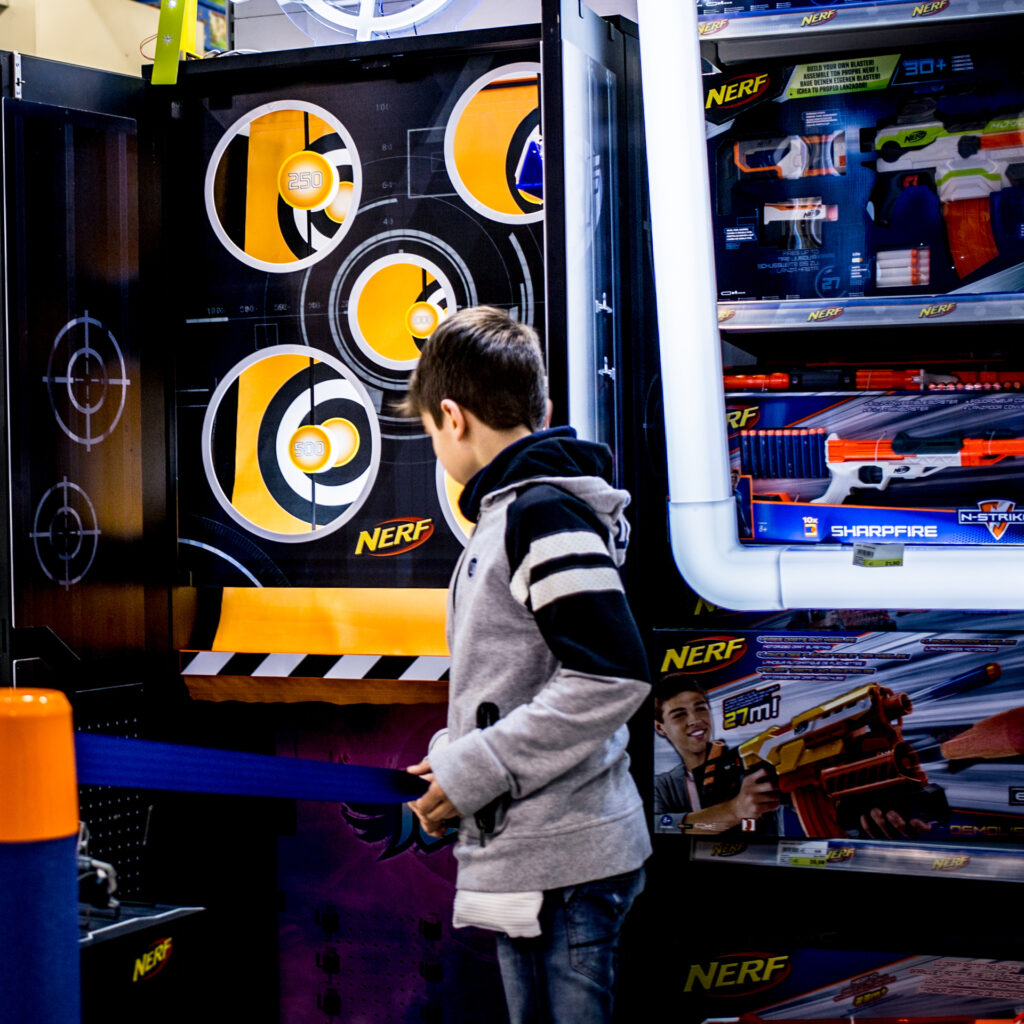
Retail displays that perform for shoppers by entertaining, delighting and educating them also result in ‘sales performance’ for retailers.
The concept was named – perhaps somewhat awkwardly – as ‘retailtainment’ by American sociologist George Ritzer in 1999 in his book entitled “Enchanting a Disenchanted World: Revolutionizing the Means of Consumption”.
Defined as “the use of sound, ambience, emotion and activity to get customers interested in the merchandise and in the mood to buy”, retailtainment is perhaps better described today as “experiential display” – though it certainly incorporates a strong element of ‘show business’.
What is experiential retail display?
The concept of experiential retail display is that the shopper’s in-store behaviour can be influenced by means of entertainment and/or education. Designing in-store product displays to appeal to shoppers’ senses not only attracts and engages them whilst in-store; it also enhances their experience and drives sales.
Music retail is a great example, and the announcement by iconic music brand HMV in July 2021 that it was returning to high street store investment suggests this is true. Speaking of his firm’s intention to open 10 new UK stores, including a London flagship, HMV CEO Doug Putman said:
“People obviously love going out shopping, they like touching and feeling and that’s something that online is not going to replace.”
Why retailers are turning to experiential display
For obvious reasons, the Covid-19 pandemic accelerated an already ongoing shift from bricks and mortar retail to online retail.
According to Statista, 71% of people were buying more online than ever before by February 2021, but this figure was already as high as 40% 12 months earlier in March 2020, when the first lockdown restrictions truly began to bite.
As the COVID lockdown lifted, retailers faced more pressure to find ways of making bricks and mortar spaces more appealing in order to tempt shoppers back into malls and high streets.
Against the convenience of order and delivery, transactional speed and choice offered by online retail giants, high street retailers need a unique sales proposition (USP).
And that’s about giving shoppers the opportunity to touch and feel products. While doing so, they can enhance the retail experiences through entertainment and education rather than simply facilitating the purchase.
Most analysts agree that experiential display is going to play a huge role in the future of in-store retail.
Where’s the proof that experiential display works?
Research shows that visitors to shopping centres now expect a fully-fledged experience rather than just retail convenience.
For retailers and brands, experiential display solutions must centre around performance both for the shopper and bottom-line sales, incorporating elements of:
- Interactivity – forging memories linked to a store and experience of its products
- Originality – marking a store out as worth visiting over its competition
- Attachment – creating a bond between the store/product and shoppers.
Retailers who get the experiential elements of their in-store mix right can expect the following benefits:
- Improved footfall
- Longer in-store dwell time
- Enhanced brand loyalty
- Increased sales – research has shown that consumers are more likely to want to own products they’ve held or interacted with
- Strong reputational value through word of mouth
- Greater integration between online sales and offline experiences.
Here at Displayplan we’ve been working at the forefront of this shift, designing, manufacturing and installing retail displays which offer the kind of full spectrum experience which retailers and their customers want.
These display solutions date back to 2017, when Displayplan were involved with the earliest stages of experiential retail.
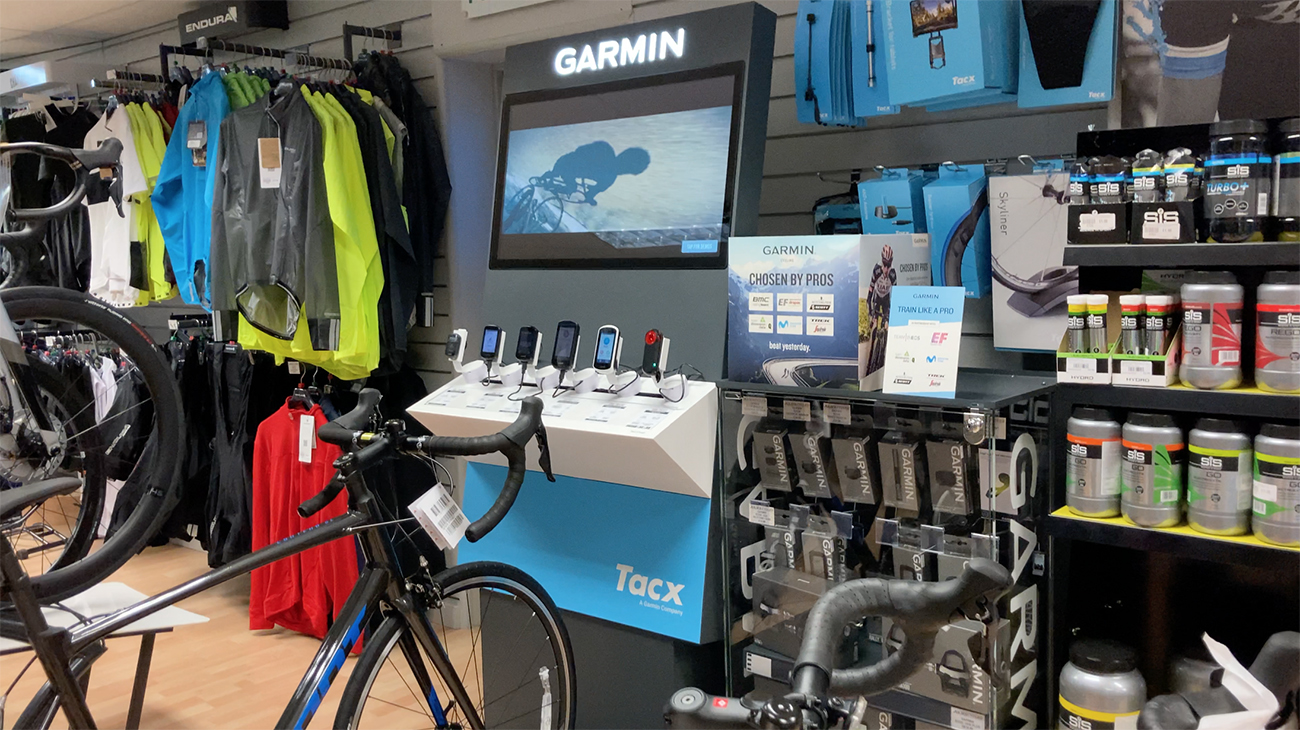
Garmin TACX Demo station
The Garmin TACX is turbo trainer is designed to provide a realistic indoor cycling work out experience with a realistic ride feel.
This experiential display for Garmin centres around a floor-standing large screen display connected to the TACX indoor training station with a bicycle.
Key experience features:
- Shoppers can test the demo bike out as well as their own work out performance
- As well as displaying performance data when shoppers lift products such as on-bike monitors, wearables and lights from the display, the screen activates to display learn and compare content
- For retail brand managers, display activity data is captured and analysed through the Connie content management platform.
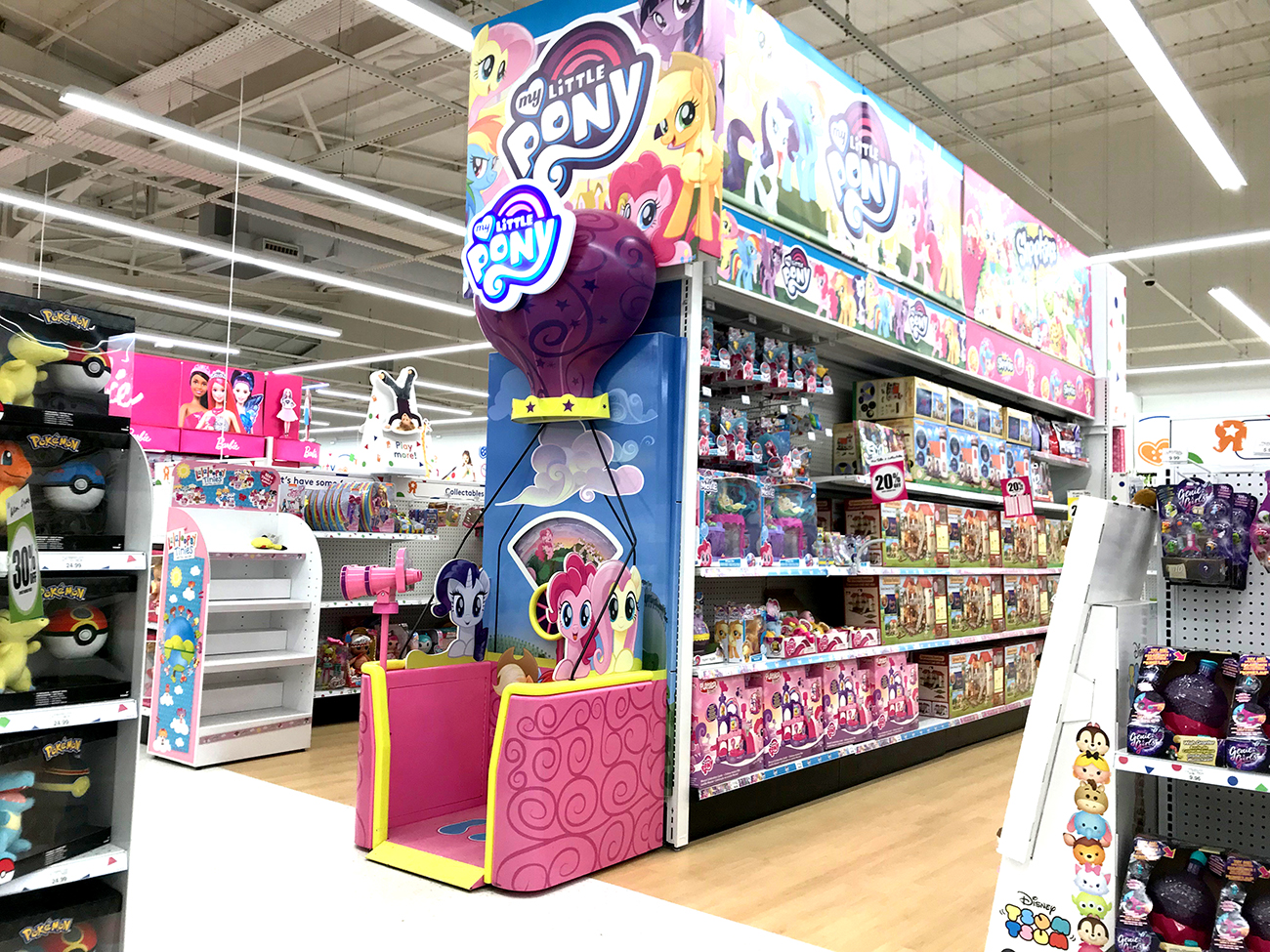
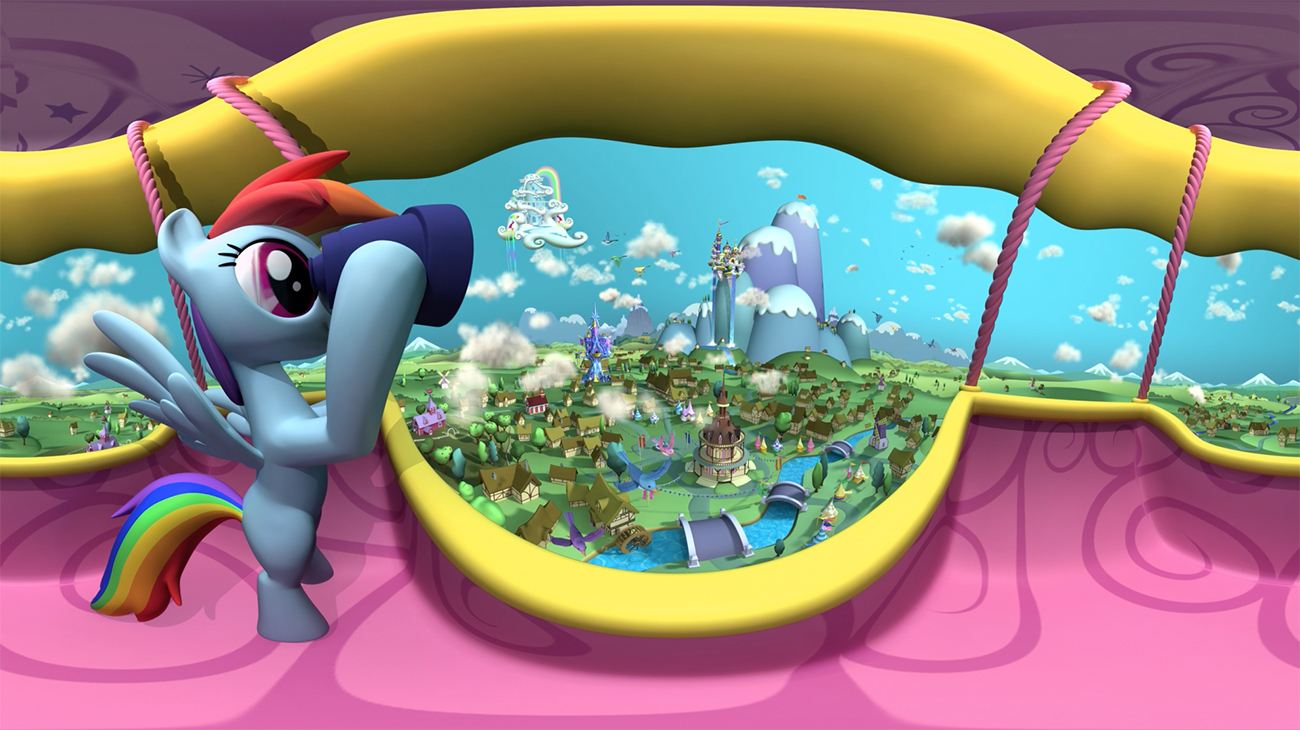
My Little Pony Platinum Endcap
The My Little Pony toy line was launched by Hasbro in 1982 and continues to delight children in the 3 to 5 years age group.
For this experiential display, Displayplan devised an end of aisle display designed for big box and hypermarket stores. Look through the binoculars and become immersed in the VR experience of My Little Pony world as you float in the ballon.
Key experience features:
- Realistic experience of the My Little Pony world for children while in-store
- Recreation of a hot air balloon basket
- Simulated flight over Equestria, the land of My Little Pony, complete with realistic air flow.
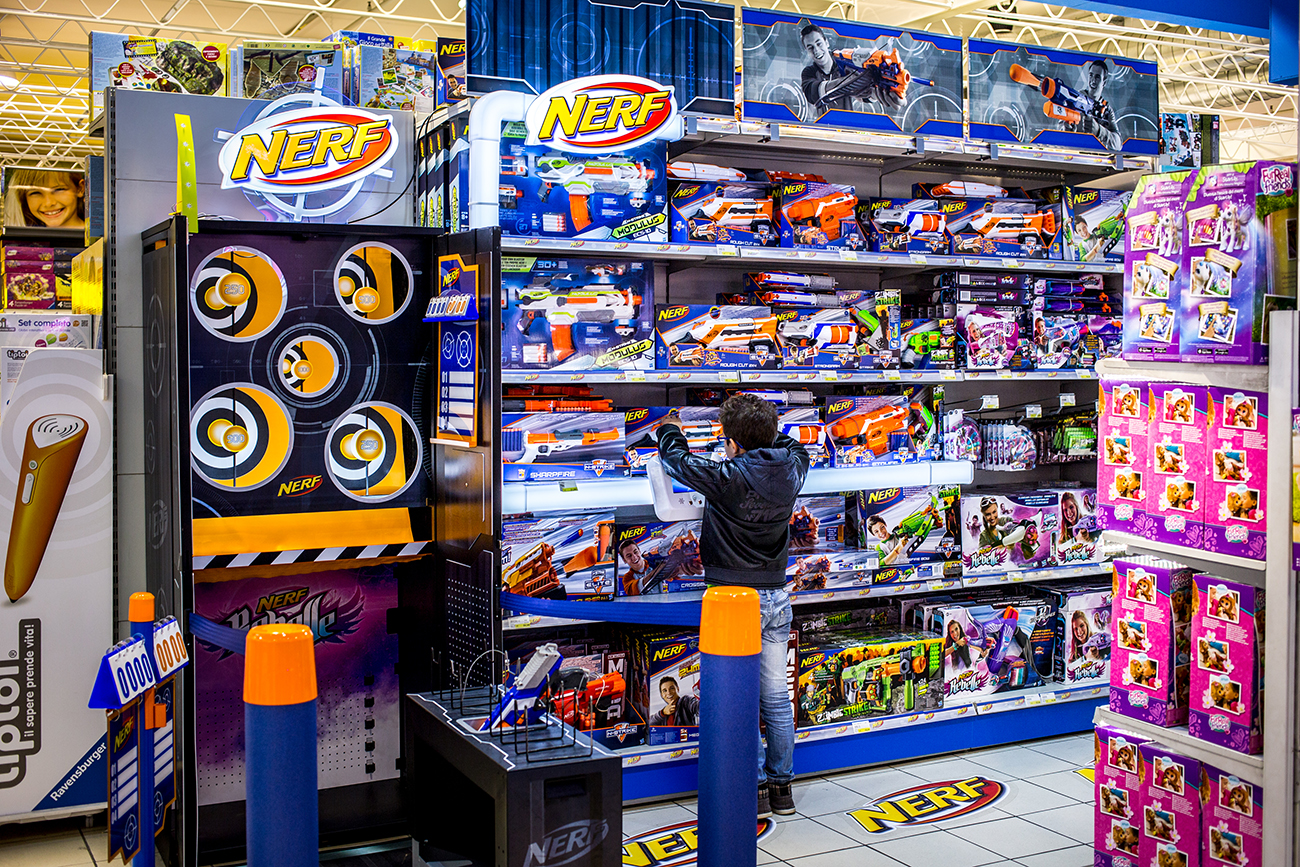
Nerf Blasters
The NERF range of toys have entertained generations of children and teenagers and include an ever-evolving range of foam dart and water blasters.
In this display, both junior and adult shoppers were offered the chance to experience Nerf blaster products in a fun, yet safe and controlled environment.
Key experience features:
- Ability for kids and adults to try out their Nerf blaster skills with targets and compete with each other in a fun and entertaining manner
- Five tethered Nerf blasters
- Backdrop which returns darts to users.
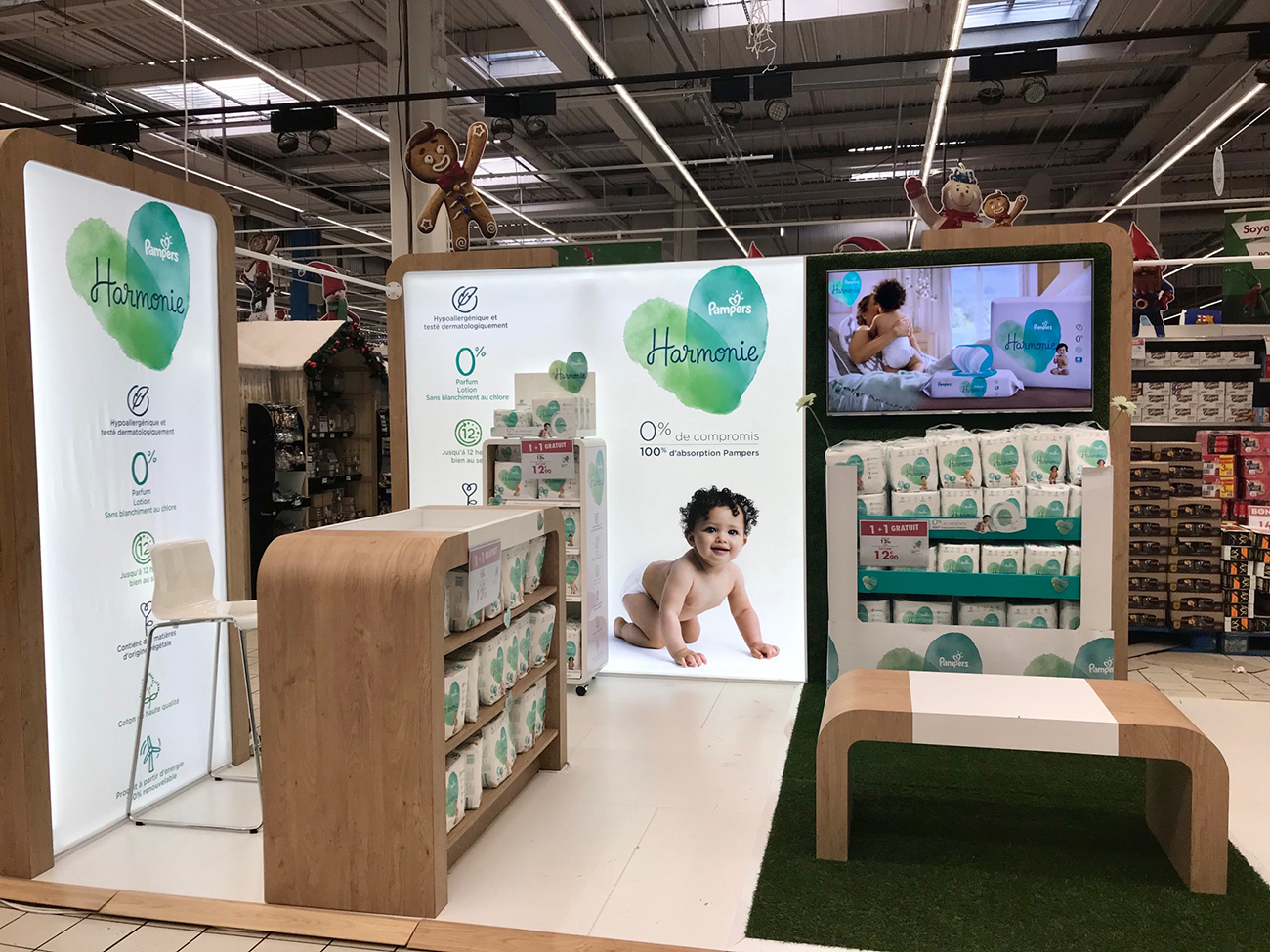
Pampers pop-up shop
The Pampers name has long been synonymous with disposable nappies. This pop-up shop display was designed by Displayplan to give shoppers the chance to step out of the main shop and into a dedicated space designed to showcase Pampers products.
The goal is to provide target shoppers with the chance to touch and feel Pampers product, using various media to educate and inform shoppers and drive engagement.
Key experience features
- High impact design featuring a large hanging mobile, light boxes, large images of babies and large format screens
- Targeted, educational content displays
- Options for shoppers to view integrated learning videos, touch and feel Pampers products or interact directly with product experts.
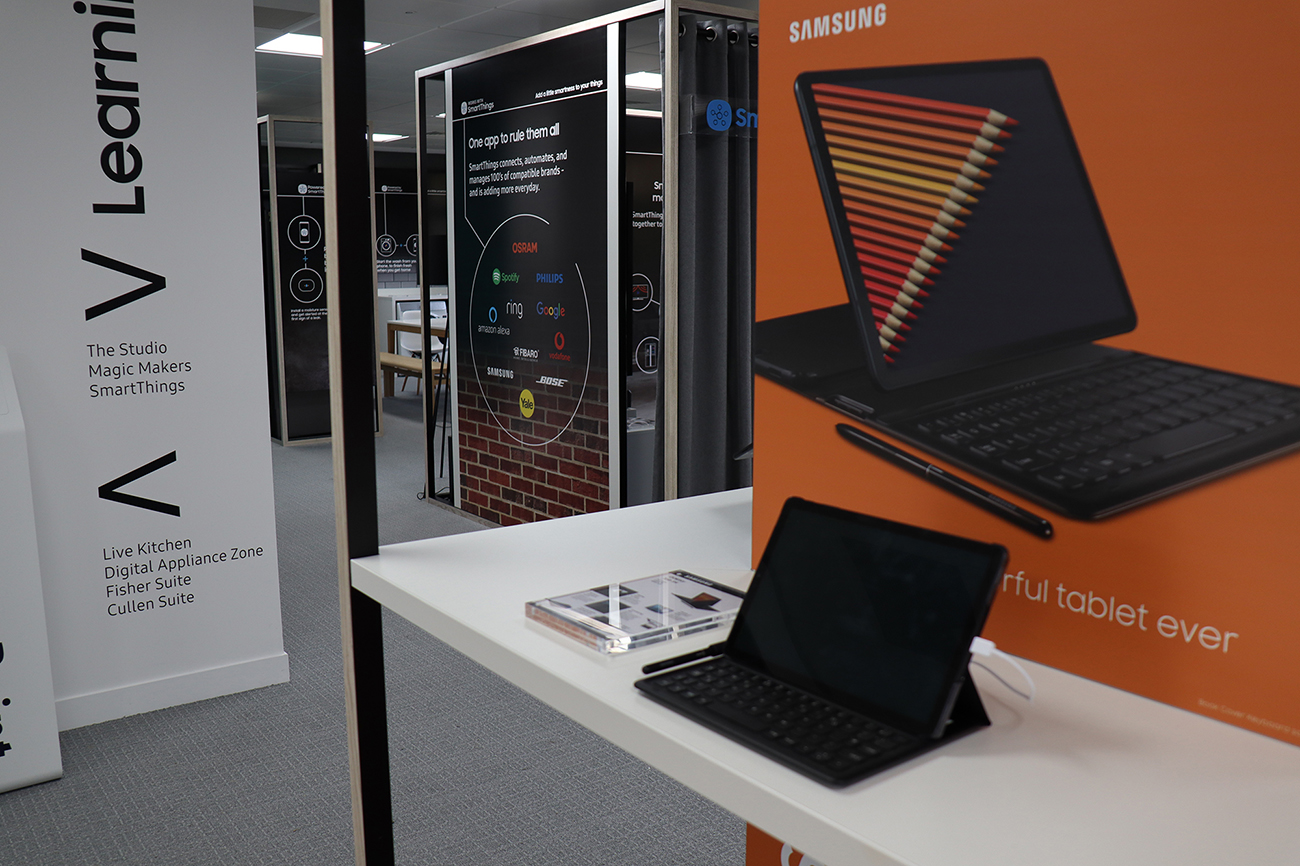
Samsung retail training centre
For Samsung, training retail associates on the history of the Samsung brand as well as on the latest products and technologies is core to success.
Displayplan designed this engaging 750 square metre technical training destination for Samsung retail sales associates across two floors.
Key experience features:
- Modular walls allowing training programme managers to create custom room sets to showcase Smart devices within a fully realised ecosystem
- Visitors are immersed in the 50-year history of Samsung
- At the same time they can experience and interact with the full range of Samsung products in a carefully recreated real world setting.
In summary
Retail displays designed to offer hands-on, educational, or retailtainment experiences like the ones showcased here perform in a variety of ways.
They appeal – in one way or another – to the senses and emotions of the target shopper, whether the child whisked away to the land of My Little Ponies, or the parent who wants to touch and feel different nappy/diaper products.
In each case, the opportunity is there for the shopper to engage with the brand, to experience the product to become invested in it.
This experience is key to nurturing brand engagement, conversion and, in the longer lifecyle of the product, loyalty.
In summary, it’s about retail experiential performance that generates retail sales performance.
Producing end-to-end retail display solutions that perform – without the drama
Speak with one of Displayplan’s Retail Display Specialists today about your experiential display goals on 01462 88 6000 or email info@displayplan.com.